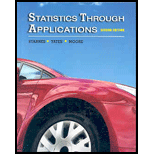
Concept explainers
a)
To find the parameter p.
a)
Answer to Problem 9.6E
Population proportion is the proportion of adults in the population who think that deaths from guns would increase.
Explanation of Solution
Given:
The Harris Poll asked a sample of 1009 adults which causes of death they thought would become more common in the future. Gun violence topped the list: 706 members of the sample thought deaths from guns would increase. Although the samples in national polls are not SRSs, they are close enough that our method gives approximately correct confidence intervals.
Explanation:
In above study, let us assume that,
n = Total number of adults = 1009
Here, population proportion is the proportion of adults in the population who think that deaths from guns would increase.
b)
To find the 95% confidence interval for p
b)
Answer to Problem 9.6E
The 95% confidence interval is, (0.671 , 0.728)
Explanation of Solution
Given:
n = Total number of adults = 1009
Formula:
Sample proportion:
Confidence interval for population proportion is,
Calculation:
Sample proportion,
Now need to find Zc
The level of significance is = a =0.05
Therefore, Zc = Z a/2 = 1.96 ..Using standard normal table
Therefore, the 95% confidence interval for population proportion is,
c)
To explain a margin of error of plus or minus 3 percentage points for this poll result.
c)
Explanation of Solution
Given:
The 95% confidence interval is, (0.671, 0.728)
Explanation:
Agree with the margin of error.
We are 95% confidence that the proportion of adults in the population who think that deaths from guns would increase is between 0.671 and 0.728
Chapter 9 Solutions
Statistics Through Applications
Additional Math Textbook Solutions
College Algebra with Modeling & Visualization (5th Edition)
Pre-Algebra Student Edition
Calculus for Business, Economics, Life Sciences, and Social Sciences (14th Edition)
Thinking Mathematically (6th Edition)
University Calculus: Early Transcendentals (4th Edition)
- The following data represent total ventilation measured in liters of air per minute per square meter of body area for two independent (and randomly chosen) samples. Analyze these data using the appropriate non-parametric hypothesis testarrow_forwardeach column represents before & after measurements on the same individual. Analyze with the appropriate non-parametric hypothesis test for a paired design.arrow_forwardShould you be confident in applying your regression equation to estimate the heart rate of a python at 35°C? Why or why not?arrow_forward
- Given your fitted regression line, what would be the residual for snake #5 (10 C)?arrow_forwardCalculate the 95% confidence interval around your estimate of r using Fisher’s z-transformation. In your final answer, make sure to back-transform to the original units.arrow_forwardCalculate Pearson’s correlation coefficient (r) between temperature and heart rate.arrow_forward
 MATLAB: An Introduction with ApplicationsStatisticsISBN:9781119256830Author:Amos GilatPublisher:John Wiley & Sons Inc
MATLAB: An Introduction with ApplicationsStatisticsISBN:9781119256830Author:Amos GilatPublisher:John Wiley & Sons Inc Probability and Statistics for Engineering and th...StatisticsISBN:9781305251809Author:Jay L. DevorePublisher:Cengage Learning
Probability and Statistics for Engineering and th...StatisticsISBN:9781305251809Author:Jay L. DevorePublisher:Cengage Learning Statistics for The Behavioral Sciences (MindTap C...StatisticsISBN:9781305504912Author:Frederick J Gravetter, Larry B. WallnauPublisher:Cengage Learning
Statistics for The Behavioral Sciences (MindTap C...StatisticsISBN:9781305504912Author:Frederick J Gravetter, Larry B. WallnauPublisher:Cengage Learning Elementary Statistics: Picturing the World (7th E...StatisticsISBN:9780134683416Author:Ron Larson, Betsy FarberPublisher:PEARSON
Elementary Statistics: Picturing the World (7th E...StatisticsISBN:9780134683416Author:Ron Larson, Betsy FarberPublisher:PEARSON The Basic Practice of StatisticsStatisticsISBN:9781319042578Author:David S. Moore, William I. Notz, Michael A. FlignerPublisher:W. H. Freeman
The Basic Practice of StatisticsStatisticsISBN:9781319042578Author:David S. Moore, William I. Notz, Michael A. FlignerPublisher:W. H. Freeman Introduction to the Practice of StatisticsStatisticsISBN:9781319013387Author:David S. Moore, George P. McCabe, Bruce A. CraigPublisher:W. H. Freeman
Introduction to the Practice of StatisticsStatisticsISBN:9781319013387Author:David S. Moore, George P. McCabe, Bruce A. CraigPublisher:W. H. Freeman





